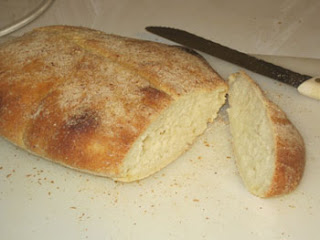As far as I can see from
wikipedia, Ciabatta's about as traditional as the ploughman's lunch. And the great Marcella Hazan doesn't even mention it as a pseudonym in
The Essentials of Italian Cooking. Instead, she has a recipe for "Olive oil bread - Mantovana", which uses a wet dough and a fairly small amount of oil. I'm sure it's heading towards the same end product.
To recap from yesterday, I mixed 200g of 00 flour with 200g of water, containing a little sugar and a teaspoon of yeast. I let that sit in the fridge overnight.
Today, I've taken it out, let it come to room temperature, then added 110g more flour, 4g salt and 20g olive oil, and kneaded that quite sloppily. What I should have realised before now is that when you've finished kneading a wet dough a tiny amount of dry flour on the surface will make it much more shapeable, without seriously affecting the mixture. So this dough is now (1130) very shallowly coated with wholemeal flour, formed into a ciabatta kind of shape, and proving.
Update and verdict
 |
| It's Italian, right? |
I put the bread into a G8 oven at 12:00 for 20 mins, then G5 for 5 mins on its back. Here's the outcome. It's less holey than I would have liked. I might have been able to prove it for longer, but it felt ready to go in. Probably a little less oil would be a good idea. Or would it? because this tastes very nice indeed. The crust is quite soft, as is the crumb, and of course the oil adds to the taste.
Meanwhile, on the question of authenticity, I've looked at Italian wikipedia's
bread article. You don't need to be able to read Italian to realise the huge variety of breads listed there. Ciabatta's not among them! The other point about this list is that it enables anyone to claim that virtually any bread they make has a propa Italian model (except maybe Chorleywood white sliced).










